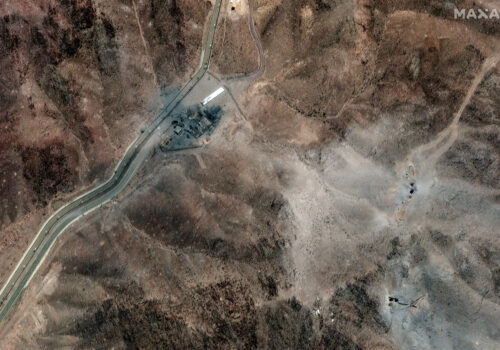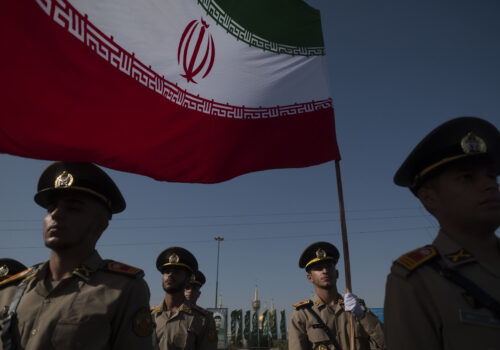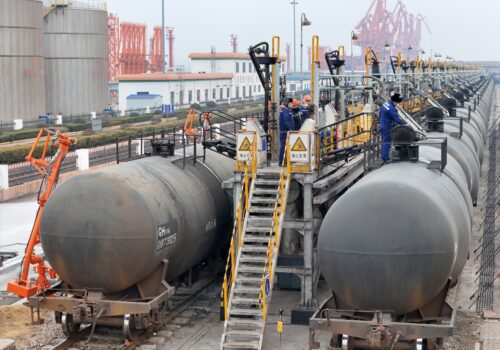The US must enforce sanctions to prevent Iran from rebuilding its nuclear program
On June 24, US President Donald Trump posted on Truth Social that China can continue to purchase Iranian oil. This announcement caused shockwaves, since it would effectively reverse long-standing US foreign policy toward not just Iran but also China, Washington’s most potent competitor in the economic and military realms. However, the next day, the White House rectified the statement, explaining that the president was simply calling attention to the fact that shipping through the Strait of Hormuz will continue.
The White House’s clarification provided some degree of relief, given that oil revenue from China is propping up Iran’s economy, and by extension Tehran’s ability to develop its nuclear program and to continue funding Hamas, Hezbollah, and other terrorist groups. However, the White House clarifying that it is not green-lighting sanctioned oil trade between Iran and China is not enough. Strengthening the enforcement of sanctions against Iran and the “Axis of Evasion” is necessary to ensure that Iran cannot rebuild its nuclear program using oil revenues it receives from China.
Iran is the most highly sanctioned country in the world
US sanctions on Iran are the most extensive and comprehensive set of economic measures that the United States maintains on any foreign government, including Russia. The objectives of these sanctions are to change the Iranian regime’s behavior, including its support for terrorism, and prevent the proliferation of nuclear weapons. The sanction authorities are captured in United Nations (UN) Security Council resolutions, executive orders, and several statutes, most of which require concurrence from (or at least notification to) Congress before sanctions can be changed or lifted.
The United States has sanctioned nearly every sector of the Iranian economy and designated thousands of individuals and entities that are a part of or associated with the regime. Sanctions target Iran’s energy and petrochemical sectors. Potential targets of US sanctions include entities that buy, sell, or transport products in these sectors, as well as foreign corporations that invest in them. This would include, for example, Chinese entities that buy Iranian oil and any banks that process those transactions.
Other sanctioned Iranian industries include shipping, construction, mining, metals, textiles, automotive, and manufacturing. Iran’s supreme leader, Ayatollah Ali Khamenei, is subject to sanctions, as are other government entities, such as the Islamic Revolutionary Guard Corps. Sanctions on Iran’s financial sector, including the Central Bank of Iran, effectively prohibit financial transactions with the country. In addition to sanctions administered by the Office of Foreign Assets Control (OFAC), the US Treasury Department’s Financial Crimes Enforcement Network (FinCEN) found the entire jurisdiction of Iran to be a primary money laundering concern in 2019, pursuant to Section 311 of the USA PATRIOT Act, which further restricts Iran’s access to the US financial system. The United States has also listed Iran as a state sponsor of terrorism since 1984.
Multilateral sanctions against Iran
Apart from the United States, the European Union (EU) and the UN also levied significant sanctions against Iran in 2005 for violating the 1967 Nonproliferation Treaty and subsequent agreements by clandestinely pursuing a nuclear weapons program.
In the past, multilateral sanctions have succeeded in bringing Iran to the negotiating table. In 2015, the United States, the United Kingdom, France, China, Russia, and Germany (P5+1), together with the EU, agreed to the Joint Comprehensive Plan Of Action (JCPOA) with Iran. Known as the “Iran nuclear deal,” the JCPOA restricted Iran’s nuclear development in exchange for the relief of some US, EU, and UN Security Council sanctions. US sanctions relief predominantly focused on oil exports, while sanctions targeting Iranian support for terrorism and other disruptive activity remained in place. However, the JCPOA did not last long.
During his first term, Trump withdrew the United States from the JCPOA and snapped back US sanctions against Iran, including secondary sanctions. Trump claimed that the JCPOA was a bad deal that “gave the Iranian regime too much in exchange for too little.” While the JCPOA is defunct, the agreement is technically still in place, since the remaining signatories did not rescind it. As a result, in October 2023, UN sanctions on Iran’s ballistic missile capabilities were sunset, consistent with the sanctions relief timeline outlined in the JCPOA.
In response, the United States, the EU, and other Western partners issued their own sanctions targeting Iran’s military-industrial complex—and its ballistic missile program, in particular—as a stopgap for the removal of UN sanctions. Notably, China and Russia, although part of the UN Security Council and signatories to the JCPOA, did not sanction Iran’s ballistic missile program. Instead, Beijing and Moscow deepened their economic relationships with Tehran following the Group of Seven (G7) coalition’s sanctions against Russia in response to its full-scale invasion of Ukraine in 2022.
During the Biden administration, the United States maintained pressure on Iran and used sanctions to target Iran’s support for Russia’s war in Ukraine, sophisticated money laundering networks, and schemes that moved money for Iran’s military and laundered oil proceeds, among other actions, often in coordination with foreign partners.
A return to maximum pressure
Soon after Trump was sworn in for his second term, he issued National Security Presidential Memorandum 2 (NSPM-2). NSPM-2 reiterates US policy toward Iran, stating that Iran must be denied nuclear weapons and intercontinental ballistic missiles. The memorandum also says that Iran’s regional aggression must be neutralized, its support for surrogates must be disrupted, and its missile development must be countered.
To achieve these goals, NSPM-2 tasks the executive branch with enacting “maximum pressure” on Iran using sanctions, diplomacy, and legal tools. Specifically, the memorandum calls on the US secretary of state to “implement a robust and continual campaign, in coordination with the Secretary of the Treasury and other relevant executive departments or agencies . . . to drive Iran’s export of oil to zero, including exports of Iranian crude to the People’s Republic of China.”
China, Iran, and the Axis of Evasion
Although multilateral sanctions have turned Iran into an economic pariah, Tehran still manages to evade sanctions and export oil to China through elaborate mechanisms and networks. While China is acting out of its own national interest, the revenue Iran generates from oil and petrochemical sales to China enables Iran to finance its nuclear program, maintain sophisticated ballistic missile capabilities, and fund its terrorist partners in the region. While imports of Iranian oil make up roughly 13.6 percent of China’s overall oil imports, these sales represent nearly 90 percent of Iran’s oil exports. In April, Iran exported approximately 1.6 million barrels per day to China.
OFAC has been targeting the networks and actors enabling this activity, pursuant to NSPM-2. In March, OFAC designated “teapot” oil refineries in China that are buying Iranian oil. In April, OFAC issued a sanctions advisory on detecting and mitigating Iranian oil sanctions evasion. In June, OFAC sanctioned additional entities in Hong Kong that are part of Iran’s “shadow banking network” that facilitates sanctions evasion and moves money from Iran’s oil sales. That same month, FinCEN issued an advisory describing Iran’s illicit and complex oil smuggling practices, noting that the majority of Iran’s sanctioned oil is sold to small independent oil refineries in China.
Enforce oil sanctions to prevent a nuclear Iran
The Trump administration’s recent social media posts about Iran sanctions have been inconsistent and confusing. However, US foreign policy toward Iran so far has not changed. Trump has not rescinded NSPM-2, Congress has not passed amendments to Iran-related statutes, and US sanctions on Iran and Iranian oil remain in place.
Instead of raising questions about the direction of US foreign policy, the White House should seize the moment it has created and ramp up execution of NSPM-2, including the enforcement of existing sanctions. Sanctions enforcement should entail diplomacy to compel third countries, such as China, to abandon smuggling or purchasing sanctioned oil. It should include information sharing with foreign partners to encourage them to sanction illicit Iranian activity and deny targeted actors access to their financial systems. Enforcement must also involve civil and criminal legal action to hold sanctions evaders accountable within US and partner-nation jurisdictions. Finally, Iran sanctions enforcement requires the use of secondary sanctions to designate foreign financial institutions involved in laundering the proceeds from Iranian oil sales.
US military strikes severely damaged Iran’s nuclear facilities, and the United States must ensure that Iran cannot build them back. Tehran maintains the ambition, technological knowledge, and industrial capacity to reconstitute its nuclear program, but its decision could come down to money. The United States should enforce its oil sanctions to deny Tehran the revenue it needs to rebuild its nuclear capabilities. This will require cracking down on the Axis of Evasion. To ensure that Tehran cannot get its hands on the financial resources it would need to rebuild its nuclear program, Iran sanctions enforcement should start with China.
Kimberly Donovan is the director of the Economic Statecraft Initiative of the Atlantic Council’s GeoEconomics Center and a former senior US Treasury official and National Security Council director of counterterrorism.
Further reading
Thu, Jun 26, 2025
What really happened to Fordow? Three possible futures for Iran’s nuclear program after US strikes.
New Atlanticist By Amir Asmar
The condition of Fordow will have a direct impact on the likelihood of Iran giving up its nuclear program versus resuming its pursuit of nuclear weapons.
Tue, Oct 8, 2024
A bipartisan Iran strategy for the next US administration—and the next two decades
Report By
As tensions spike in the Middle East, how should the next US president approach Iran and its network of proxies including Hezbollah and Hamas? With a strategy that can be maintained for decades, by administrations of either party. A bipartisan, expert working group lays out the details.
Thu, Mar 28, 2024
The axis of evasion: Behind China’s oil trade with Iran and Russia
New Atlanticist By Kimberly Donovan, Maia Nikoladze
Beijing has developed a way to import Iranian and Russian oil while bypassing the Western financial system and shipping services.
Image: A gas flare on an oil production platform is seen alongside an Iranian flag in the Gulf July 25, 2005. REUTERS/Raheb Homavandi/File Photo



